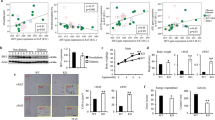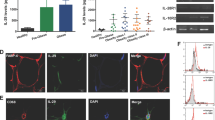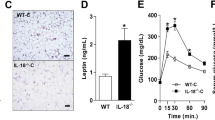Abstract
Background:
Obesity is a severe health problem worldwide, which leads to multiple comorbidities including type 2 diabetes mellitus and cardiovascular diseases. Inflammation has been found to be an important characteristic of adipose tissue in obese subjects. However, obesity is also associated with compromised immune responses to infections and the impact of obesity on immune function has not been fully understood.
Subjects/Methods:
To clarify the role of obesity in the immune responses, we investigated the Toll-like receptor (TLR)-induced cytokine secretion by leukocytes from obese and lean subjects. We also investigated the relationship between insulin-induced intracellular signaling and cytokine production using peripheral blood mononuclear cells (PBMCs) and a monocytic cell line THP-1.
Results:
We found decreased TLR-induced interferon-γ, interleukin-6 (IL-6) and tumor necrosis factor-α secretions and elevated IL-10 secretion by leukocytes from obese subjects when compared with lean controls. PBMCs from obese subjects showed enhanced basal Akt and glycogen synthase kinase-3β (GSK-3β) phosphorylation, which did not further increase with insulin and lipopolysaccharide (LPS) stimulation. We also found that LPS-induced IκBα degradation was inhibited in PBMCs from obese subjects. By using THP-1 cells with GSK-3β knockdown or cells treated with hyperinsulinemic and high-fatty acid conditions, we found that LPS-induced nuclear factor κB (NF-κB) activation was inhibited and cyclic adenosine monophosphate response element-binding protein (CREB) activation was enhanced.
Conclusions:
These findings indicate that GSK-3β is important in the regulation of NF-κB and CREB activation in leukocytes under the metabolic condition of obesity. Our study revealed a key mechanism through which metabolic abnormalities compromise leukocyte functions in people with obesity.
This is a preview of subscription content, access via your institution
Access options
Subscribe to this journal
Receive 12 print issues and online access
$259.00 per year
only $21.58 per issue
Buy this article
- Purchase on Springer Link
- Instant access to full article PDF
Prices may be subject to local taxes which are calculated during checkout





Similar content being viewed by others
References
Meshkani R, Adeli K . Hepatic insulin resistance, metabolic syndrome and cardiovascular disease. Clin Biochem 2009; 42: 1331–1346.
Odegaard JI, Chawla A . Pleiotropic actions of insulin resistance and inflammation in metabolic homeostasis. Science 2013; 339: 172–177.
Bunn RC, Cockrell GE, Ou Y, Thrailkill KM, Lumpkin CK Jr, Fowlkes JL . Palmitate and insulin synergistically induce IL-6 expression in human monocytes. Cardiovasc Diabetol 2010; 9: 73.
Dasu MR, Jialal I . Free fatty acids in the presence of high glucose amplify monocyte inflammation via Toll-like receptors. Am J Physiol Endocrinol Metab 2011; 300: E145–E154.
Huttunen R, Syrjanen J . Obesity and the risk and outcome of infection. Int J Obes (Lond) 2013; 37: 333–340.
Karlsson EA, Beck MA . The burden of obesity on infectious disease. Exp Biol Med 2010; 235: 1412–1424.
Arslan E, Atilgan H, Yavasoglu I . The prevalence of Helicobacter pylori in obese subjects. Eur J of Intern Med 2009; 20: 695–697.
Centers for Disease C, Prevention. Intensive-care patients with severe novel influenza A (H1N1) virus infection - Michigan, June 2009. MMWR Morb Mortal Wkly Rep 2009; 58: 749–752.
Amar S, Zhou Q, Shaik-Dasthagirisaheb Y, Leeman S . Diet-induced obesity in mice causes changes in immune responses and bone loss manifested by bacterial challenge. Proc Natl Acad Sci USA 2007; 104: 20466–20471.
Strandberg L, Verdrengh M, Enge M, Andersson N, Amu S, Onnheim K et al. Mice chronically fed high-fat diet have increased mortality and disturbed immune response in sepsis. PloS one 2009; 4: e7605.
Chang ZL . Important aspects of Toll-like receptors, ligands and their signaling pathways. Inflamm Res 2010; 59: 791–808.
Hussain R, Kaleem A, Shahid F, Dojki M, Jamil B, Mehmood H et al. Cytokine profiles using whole-blood assays can discriminate between tuberculosis patients and healthy endemic controls in a BCG-vaccinated population. J Immunol Methods 2002; 264: 95–108.
Dandona P, Aljada A, Mohanty P, Ghanim H, Hamouda W, Assian E et al. Insulin inhibits intranuclear nuclear factor kappaB and stimulates IkappaB in mononuclear cells in obese subjects: evidence for an anti-inflammatory effect? J Clin Endocrinol Metab 2001; 86: 3257–3265.
Lumeng CN . Innate immune activation in obesity. Mol Aspects Med 2013; 34: 12–29.
Martin M, Rehani K, Jope RS, Michalek SM . Toll-like receptor-mediated cytokine production is differentially regulated by glycogen synthase kinase 3. Nat Immunol 2005; 6: 777–784.
Nandan D, Camargo de Oliveira C, Moeenrezakhanlou A, Lopez M, Silverman JM, Subek J et al. Myeloid cell IL-10 production in response to leishmania involves inactivation of glycogen synthase kinase-3beta downstream of phosphatidylinositol-3 kinase. J Immunol 2012; 188: 367–378.
Eldar-Finkelman H, Schreyer SA, Shinohara MM, LeBoeuf RC, Krebs EG . Increased glycogen synthase kinase-3 activity in diabetes- and obesity-prone C57BL/6J mice. Diabetes 1999; 48: 1662–1666.
Hsu MC, Chang CS, Lee KT, Sun HY, Tsai YS, Kuo PH et al. Central obesity in males affected by a dyslipidemia-associated genetic polymorphism on APOA1/C3/A4/A5 gene cluster. Nutr Diabetes 2013; 3: e61.
Feinberg J, Fieschi C, Doffinger R, Feinberg M, Leclerc T, Boisson-Dupuis S et al. Bacillus Calmette Guerin triggers the IL-12/IFN-gamma axis by an IRAK-4- and NEMO-dependent, non-cognate interaction between monocytes, NK, and T lymphocytes. Euro J Immunol 2004; 34: 3276–3284.
Liu SY, Wang WZ, Yen CL, Tsai MY, Yang PW, Wang JY et al. Leukocyte nicotinamide adenine dinucleotide phosphate-reduced oxidase is required for isocyanate-induced lung inflammation. J Allergy Clin Immunol 2011; 127: 1014–1023.
Huang WC, Tsai CC, Chen CL, Chen TY, Chen YP, Lin YS et al. Glucosylceramide synthase inhibitor PDMP sensitizes chronic myeloid leukemia T315I mutant to Bcr-Abl inhibitor and cooperatively induces glycogen synthase kinase-3-regulated apoptosis. FASEB J 2011; 25: 3661–3673.
van Dooren FH, Duijvis NW, te Velde AA . Analysis of cytokines and chemokines produced by whole blood, peripheral mononuclear and polymorphonuclear cells. J Immunol Methods 2013; 396: 128–133.
Xing L, Remick DG . Relative cytokine and cytokine inhibitor production by mononuclear cells and neutrophils. Shock 2003; 20: 10–16.
Damsgaard CT, Lauritzen L, Calder PC, Kjaer TM, Frokiaer H . Whole-blood culture is a valid low-cost method to measure monocytic cytokines - a comparison of cytokine production in cultures of human whole-blood, mononuclear cells and monocytes. J Immunol Methods 2009; 340: 95–101.
Staehr P, Hother-Nielsen O, Landau BR, Chandramouli V, Holst JJ, Beck-Nielsen H . Effects of free fatty acids per se on glucose production, gluconeogenesis, and glycogenolysis. Diabetes 2003; 52: 260–267.
Wen AY, Sakamoto KM, Miller LS . The role of the transcription factor CREB in immune function. J Immunol 2010; 185: 6413–6419.
Andersson CX, Gustafson B, Hammarstedt A, Hedjazifar S, Smith U . Inflamed adipose tissue, insulin resistance and vascular injury. Diabetes Metab Res Rev 2008; 24: 595–603.
Falagas ME, Kompoti M . Obesity and infection. Lancet Infect Dis 2006; 6: 438–446.
Chang JT, Dou HY, Yen CL, Wu YH, Huang RM, Lin HJ et al. Effect of type 2 diabetes mellitus on the clinical severity and treatment outcome in patients with pulmonary tuberculosis: a potential role in the emergence of multidrug-resistance. J Formos Med Assoc 2011; 110: 372–381.
Jain S, Chaves SS . Obesity and influenza. Clin Infect Dis 2011; 53: 422–424.
Gleeson M, Bishop N, Oliveira M, McCauley T, Tauler P, Muhamad AS . Respiratory infection risk in athletes: association with antigen-stimulated IL-10 production and salivary IgA secretion. Scand J Med Sci Sports 2012; 22: 410–417.
Hill JR, Kwon G, Marshall CA, McDaniel ML . Hyperglycemic levels of glucose inhibit interleukin 1 release from RAW 264.7 murine macrophages by activation of protein kinase C. J Biol Chem 1998; 273: 3308–3313.
Turina M, Fry DE, Polk HC Jr . Acute hyperglycemia and the innate immune system: clinical, cellular, and molecular aspects. Crit Care Med 2005; 33: 1624–1633.
Kidd LB, Schabbauer GA, Luyendyk JP, Holscher TD, Tilley RE, Tencati M et al. Insulin activation of the phosphatidylinositol 3-kinase/protein kinase B (Akt) pathway reduces lipopolysaccharide-induced inflammation in mice. J Pharmacol Exp Ther 2008; 326: 348–353.
Cohen P . The Croonian Lecture 1998. Identification of a protein kinase cascade of major importance in insulin signal transduction. Philos Trans R Soc Lond B Biol Sci 1999; 354: 485–495.
van den Berghe G, Wouters P, Weekers F, Verwaest C, Bruyninckx F, Schetz M et al. Intensive insulin therapy in critically ill patients. N Engl J Med 2001; 345: 1359–1367.
Zhou Q, Leeman SE, Amar S . Signaling mechanisms involved in altered function of macrophages from diet-induced obese mice affect immune responses. Proc Natl Acad Sci USA 2009; 106: 10740–10745.
Cremer TJ, Shah P, Cormet-Boyaka E, Valvano MA, Butchar JP, Tridandapani S . Akt-mediated proinflammatory response of mononuclear phagocytes infected with Burkholderia cenocepacia occurs by a novel GSK3beta-dependent, IkappaB kinase-independent mechanism. J Immunol 2011; 187: 635–643.
Hansen T, Rehfeld JF, Nielsen FC . GSK-3beta reduces cAMP-induced cholecystokinin gene expression by inhibiting CREB binding. Neuroreport 2004; 15: 841–845.
Ahmad R, Al-Mass A, Atizado V, Al-Hubail A, Al-Ghimlas F, Al-Arouj M et al. Elevated expression of the toll like receptors 2 and 4 in obese individuals: its significance for obesity-induced inflammation. J Inflamm 2012; 9: 48.
Galic S, Oakhill JS, Steinberg GR . Adipose tissue as an endocrine organ. Mol Cell Biol 2010; 316: 129–139.
Fang X, Yu S, Tanyi JL, Lu Y, Woodgett JR, Mills GB . Convergence of multiple signaling cascades at glycogen synthase kinase 3: Edg receptor-mediated phosphorylation and inactivation by lysophosphatidic acid through a protein kinase C-dependent intracellular pathway. Mol Cell Biol 2002; 22: 2099–2110.
Quan J, Liu J, Gao X, Liu J, Yang H, Chen W et al. Palmitate induces interleukin-8 expression in human aortic vascular smooth muscle cells via Toll-like receptor 4/nuclear factor-kappaB pathway (TLR4/NF-kappaB-8). J Diabetes 2014; 6: 33–41.
Ban JO, Kwak DH, Oh JH, Park EJ, Cho MC, Song HS et al. Suppression of NF-kappaB and GSK-3beta is involved in colon cancer cell growth inhibition by the PPAR agonist troglitazone. Chem Biol Interact 2010; 188: 75–85.
Lee S, Yang WK, Song JH, Ra YM, Jeong JH, Choe W et al. Anti-obesity effects of 3-hydroxychromone derivative, a novel small-molecule inhibitor of glycogen synthase kinase-3. Biochem Pharmacol 2013; 85: 965–976.
Acknowledgements
We thank Professor S-J Tsai, Professor Y-S Lin and Professor T-M Yeh for helpful discussion. This work was supported by National Cheng Kung University Hospital grant (NCKUH9801002).
Author information
Authors and Affiliations
Corresponding author
Ethics declarations
Competing interests
The authors declare no conflict of interest.
Additional information
Supplementary Information accompanies this paper on International Journal of Obesity website
Rights and permissions
About this article
Cite this article
Yen, CL., Chao, WC., Wu, CH. et al. Phosphorylation of glycogen synthase kinase-3β in metabolically abnormal obesity affects immune stimulation-induced cytokine production. Int J Obes 39, 270–278 (2015). https://doi.org/10.1038/ijo.2014.93
Received:
Revised:
Accepted:
Published:
Issue Date:
DOI: https://doi.org/10.1038/ijo.2014.93



